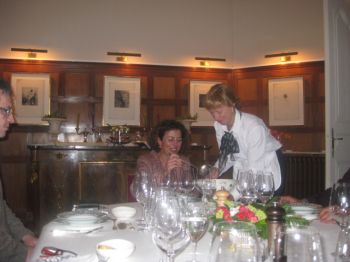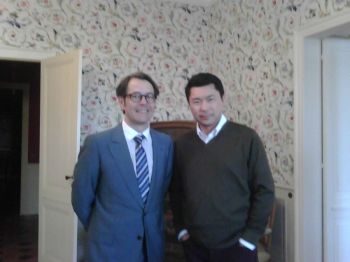
Celine Villars-Foubet
"So what vintage do you think this is?" asks charming hostess Celine Villars-Foubet, an owner of the 1855 Grand Cru Chateau Camensac (and many others). We are sitting at a round table inside the very grand Chateau Chasse Spleen (another Chateau of hers) enjoying vibrant green watercress soup and an unknown red wine.
"2001," I say, even though the other wine journalists around the table have guessed vintages as late as 2006 because of the vibrant dark color (wine becomes more pale with age) and fresh acidity. I am right — then again, I admit having had the opportunity to taste through the vintages that morning with Celine’s equally charming husband Jean-Pierre Foubert. I had been amazed by the vibrancy in this wine that presents itself in such youthful form after a decade of bottle age.
Jean-Pierre Foubet (suit) & journalist Simon Tan
Chateau Camensac is what is known as a "fifth growth" in the division that divided the Medoc into five different classes in 1855. And just as Americans have a popular saying that one never has a second chance to make a first impression, it is true with the 1855 system that it is amazingly difficult to "jump" to another class. The leaders of the civic association did not arbitrarily divide the Chateaux into classes on a whim or personal taste — instead they looked at the record books of negotiants and divided the Chateaux based on the prices their wines fetched in the marketplace.
Though the land and cellar that are Chateau Camensac have been around for nearly two hundred years, parts of the actual Chateau are quite new and its original owners would be hard-pressed to recognize it today. They would undoubtedly recognize its terroir, which borders the Saint-Julien appellation, in the commune of Saint-Laurent-Medoc. The vines are located on the town’s finest gravelly rise. The soil has many pebbles and is quite deep. Supposedly, this makes for excellent drainage (crucial to quality wine) — and today would be proof as it is raining so hard the marshland surrounding the Chateau is nearly under water. Yet, true to its reputation, the land outside my window here at Chateau Camensac looks almost dry.
The Vineyard has a density of vines per hectare 10.000, with 60 percent Cabernet Sauvignon and 40 percent Merlot. The average age of the vines is over forty, which naturally restricts yields, and green harvesting (removing grapes before they are ripe to further increase concentration) is practiced. As a result, the average yield does not exceed 40-45 hectoliters per hectare. Harvest is a nervous time for the producers here, as grapes must be picked when perfectly ripe yet before bad weather sets in.
During my tasting this morning (1999 – 2009) I really enjoyed this wine, and beyond being impressed by its fresh acidity and color after so much bottle age, could taste the terroir in every vintage — a sort of very earthy sensation that spoke of the mineral content of the soil, and especially in the older vintages, the flavors that develop when ripe fruit mellows into tertiary flavors that are often redolent of truffles and mushrooms. Watch out for the 2009 vintage when it reaches your local wine shop.
